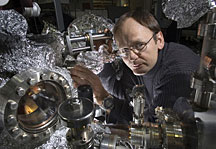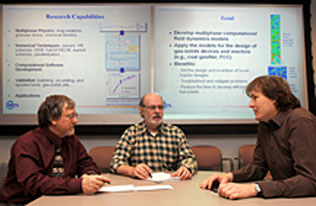Research
Highlights...
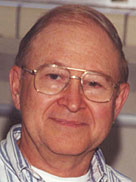
|
Ames's Lab's
Robert Angelici
|
|
 |
Number 224 |
December 11, 2006 |
|
"Pseudogap" origin revealed
Research at DOE's Brookhaven Lab appears to resolve one mystery in the 20-year study of high-temperature (high-T c ) superconductors — the origin of a “pseudogap” in the energy level of the materials' electronic spectrum. The Brookhaven research shows that the pseudogap is the result of electrons pairing up above the transition temperature to the superconducting state. These pairs have strongly fluctuating phases, so they cannot behave collectively as soon as they are formed. Only by cooling the material to much lower temperatures do the phase fluctuations become suppressed. At a certain temperature, the phase becomes locked so the electron pairs act coherently — and the system becomes a superconductor. [Karen McNulty Walsh, 631/344-8350,
kmcnulty@bnl.gov]
|
|
A new picture of the pion
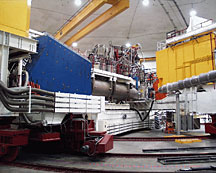 |
| Detectors in Jefferson Lab's Hall C help scientists gain new insight into the strong force. Shown are the short orbit spectrometer (right) and the high momentum spectrometer (left). |
Using the Continuous Electron Beam Accelerator Facility at DOE's Jefferson Lab, scientists have snapped the most precise picture yet of the pion. The pion is a common subatomic particle built of two quarks bound together by the strong force. Also present is the quark-gluon sea, a strong-force driven bevy of quarks, anti-quarks and strong force glue particles called gluons. Studying the pion's relatively simple structure can provide new insight into the nature of the strong force. The experiment has thus far provided evidence that the quark-gluon sea does play an important role in the pion's basic structure. [Kandice Carter, 757/269-7263,
kcarter@jlab.org]
|
|
INL's Explosives detection system to be installed at U.S. Air Base
A team from DOE's Idaho National Laboratory have spent the last four years perfecting an explosives detection system to assist Air Force security professionals detect the presence of smuggled explosives entering military bases. The award-winning Idaho Explosives Detection System will be installed at Ohio's Wright-Patterson Air Force Base for semi-permanent field testing.
The system relies on a technique called pulsed thermal neutron generation. If nitrogen-based explosive signatures are detected, the IEDS will alert operators in about five minutes. The inspection time allows a large amount of statistical data to be captured, ensuring that the results are accurate to within 95 percent. [Ethan Huffman, 208/526-0660,
Ethan Huffman@inl.gov]
|
Cold shot
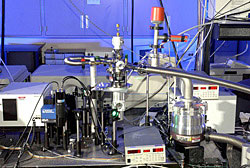 |
| Cryogenic Time-resolved Laser Fluorescence Spectrometer |
Scientists have long known that uranium salts glow greenish-yellow in ultraviolet light. An oddity about their UV glow, or fluorescence spectra: The resolution of the spectral fingerprint becomes sharper as the temperature falls. Scientists at DOE's Pacific Northwest National Laboratory are now applying a technique called cryogenic fluorescence spectroscopy to uranium in contaminated soil at a former nuclear fuel manufacturing site. By cooling the sediments to minus 267 degrees Celsius—near the temperature of liquid helium—the PNNL team, working at the Environmental Molecular Sciences Laboratory, hit a sample with UV laser on a contaminated sample to coax a uranium fluorescence intensity of more than five times that at room temperature. Other spectra that were absent at room temperature popped out when frozen, enabling researchers to distinguish different forms of uranium from one another, including uranium-carbonate that moves readily underground and is a threat to water supplies. [Bill Cannon, 509/375-3732,
cannon@pnl.gov]
|
New approach for continuous real-time analysis of rad waste
An improved monitoring system for providing continuous analysis of high-level radioactive waste has been developed by researchers at DOE's Pacific Northwest National Laboratory. On-line Raman spectroscopy quickly generates real-time data and analysis. The monitoring system is capable of simultaneously and continuously quantifying the levels of all the chemically significant anions within the waste. The total sodium ion concentration is also determined independently by modeling inputs from on-line conductivity and density meters. The system is adaptable to monitoring in a variety of harsh environments. In addition to radioactive tank wastes, the system components and analytical tools of the process monitor can be tailored to watch for a variety of complex mixtures such as pulp and paper processing liquids, and electroplating solutions.
[Geoff Harvey, 509/372-6083,
geoffrey.harvey@pnl.gov]
|
|
|
Avoiding Fads
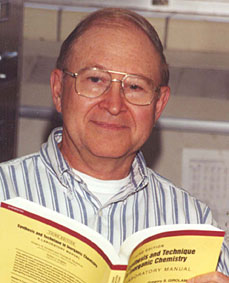 |
Robert Angelici |
Ames Laboratory inorganic chemist Robert Angelici is known for pursuing unique and challenging research problems and then developing fundamental concepts that may be applied to related fields. "I enjoy the thrill of exploring new ideas and directions," he says. If there ís a 'fad' area, I'll avoid it and develop my own direction.
Angelici has made substantial contributions to the chemistry of the transition metals. He has used transition metals to stabilize molecules that would otherwise decompose. On the other hand, he has used transition metal complexes to increase the reactivity of otherwise unreactive molecules that are present in petroleum. He has also investigated catalytic conversions of petroleum and biodiesel components to potentially useful commercial products. Some of these studies involved a conceptually new type of catalyst consisting of a metal complex tethered to the surface of silica that also contains a different transition metal.
Currently, Angelici is pursuing two new efforts related to transition metals. One project examines the effects of transition metal binding on the shape and properties of curved carbon surfaces that are fragments of buckminsterfullerene. Another project focuses on the catalytic power of metallic gold, long considered a poor catalyst. Angelici now finds that this metal rapidly catalyzes reactions of carbon monoxide, amines, and oxygen. The DOE's Office of Science, Basic Energy Sciences Program, Chemical Sciences Division provides funding for both projects.
Committed to helping train new generations of inorganic chemists, Angelici developed the first textbook of inorganic laboratory techniques, Synthesis and Technique in Inorganic Chemistry, which is still used in many colleges and universities.
The text, first published in 1969 and now in its third edition, has had "a rather remarkable run," says Angelici.
An outstanding researcher and an inspiring teacher, Angelici will receive the American Chemical Society Award for Distinguished Service in the Advancement of Inorganic Chemistry at the 2007 ACS National Meeting and Exposition in March.
Submitted by DOE's Ames Laboratory
|
|


